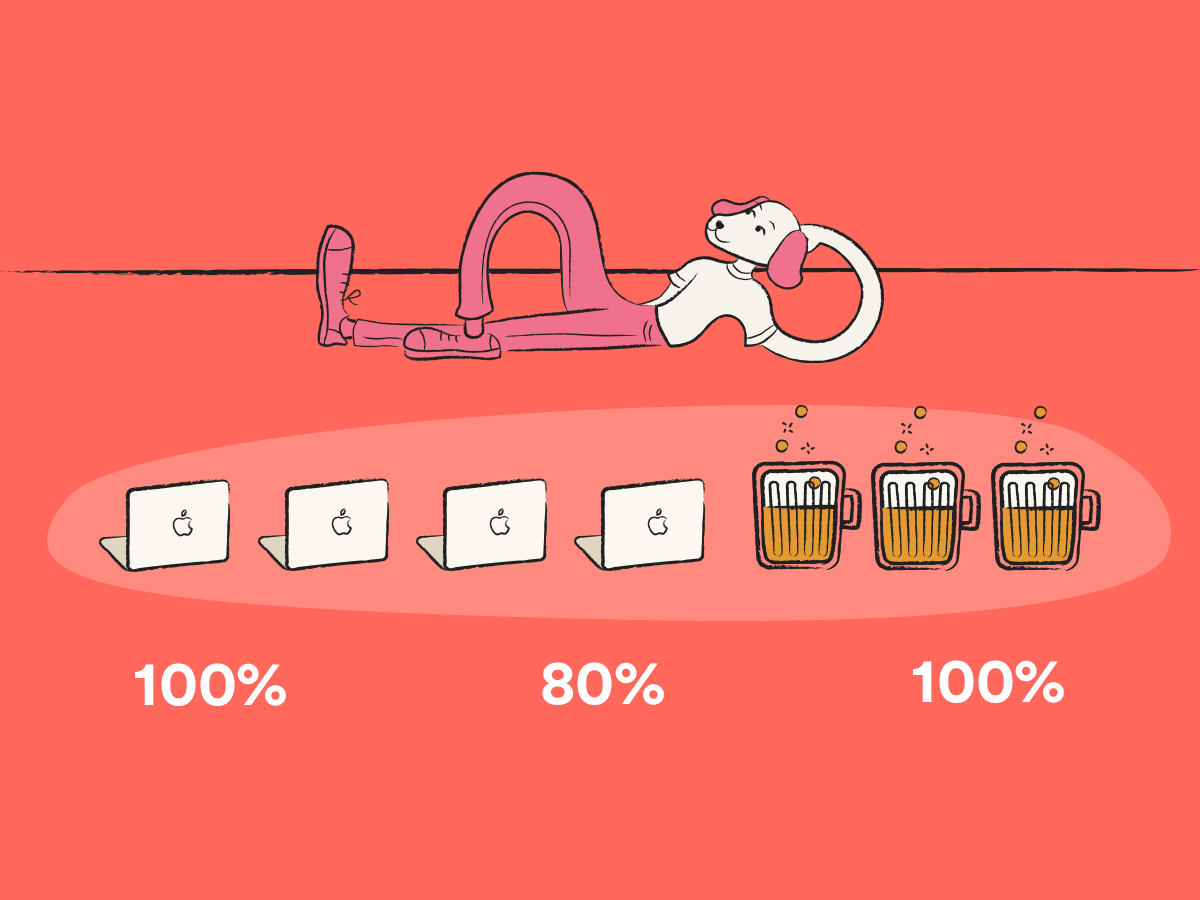100, 80, 100.
That’s our mantra for the rest of the year — alongside 70 other companies. 100% pay for 80% hours, with a promise to maintain 100% productivity.
Starting 6 June, approximately 3,300 employees across the UK have kicked off a six-month trial trimming the standard work week from 5 days to 4 days. The experiment is organized by the non-profit groups ‘4 Day Week Global’ and ‘4 Day Week UK Campaign’, along with ‘Autonomy’, a think tank that studies the impact of labor on well-being.
Researchers at Oxford, Cambridge, and Boston Universities will publish results in 2023 after overseeing how this move impacts employee productivity and happiness across each of the participating companies.
And we’re one of them.
Why, we hear you incredulously ask. Who in their right mind would knock off one day every week without reducing employee pay?
How could a company survive like this, let alone thrive?
We see where you’re coming from, and we’re here to show you where we’re coming from. Because while it may seem like an angry wish uttered on a Monday morning, the four-day work week actually has a lot more going for it than initially meets the eye.
Let’s understand why we think the four-day work week will prove a turning point in the way companies operate, and potentially in how we think of work itself.
The four-day work week: not as radical as you imagine
In the right context, the four-day work week is less a radical idea and more a natural step in the right direction.
Take the history of work hours. In 1890, the US Government estimated that an industrial worker put in about 100 hours of work per week. That’s right, one hundred, averaging just shy of 15 hours a day with no weekends.
Thankfully, this practice was soon challenged by labor unions and trade unions campaigning for more humane working conditions. These movements saw rapid success in the early 20th century. By 1913, there were 2.7 million members registered with trade and labor unions, campaigning against the detrimental nature of their work hours.
Their increasing numbers made front-page headlines in newspapers and academic journals, pressuring industry leaders and politicians to address union members’ concerns.
As a result of their efforts, the 100-hour work week was brought down to 40 hours by 1950 — a 60-hour drop in 60 years or roughly 1 hour dropped per year. It’s been 71 years since 1950. Don’t you think the old 40-hour week deserves a little makeover to keep with the times?
Alternatively, let’s consider the (admittedly uneven) practice of four-day work around the world. Several experts, employees, and even a handful of reputed companies have endorsed and partly introduced a four-day work week before the pandemic.
In November 2019, Microsoft Japan made headlines declaring a 40% boost in productivity after a four-day work week trial. On the other side of the world, Adam Grant, organizational psychologist at the University of Pennsylvania’s Wharton School of Business, made the case for implementing shorter work weeks at the World Economic Forum.
Even on an anecdotal level, a lot of us have known someone who bagged that one lucky job allowing them Fridays off after 32 hours of work from Monday to Thursday (do you want to be that someone? We recommend the awesome 4/day week website to get you started).
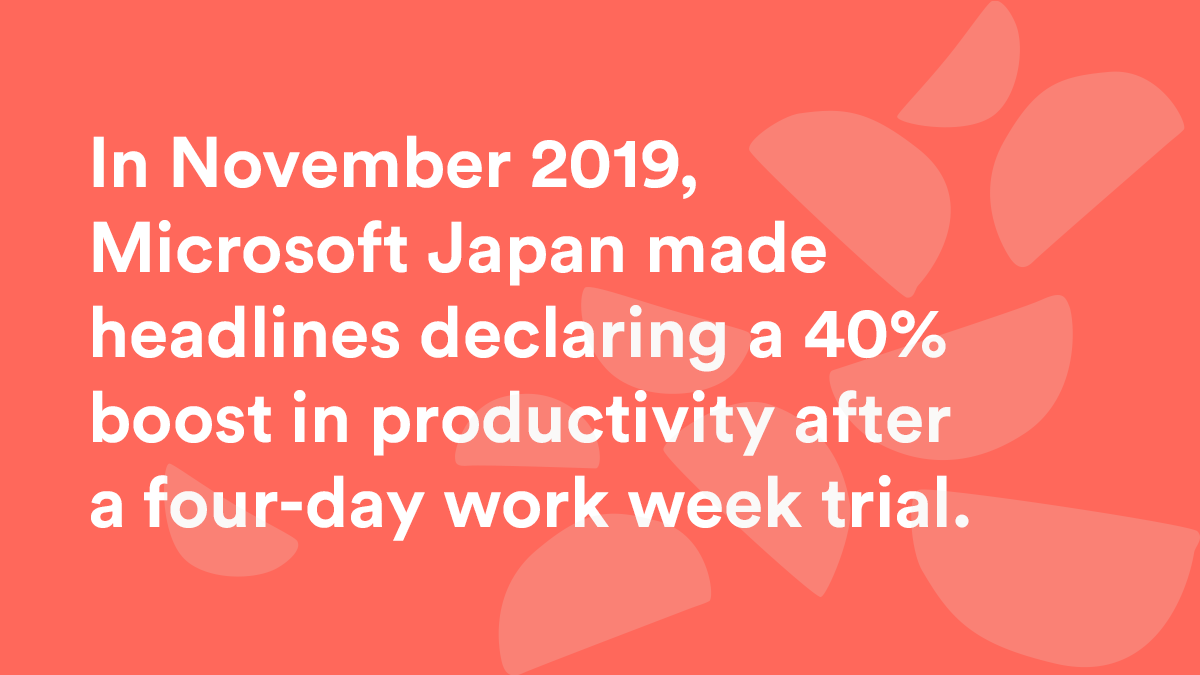
Thus, contrary to what some detractors argue, the four-day work week isn’t just a recent knee-jerk reaction to the covid pandemic. While it’s true that the pandemic catalyzed research in this direction (after all, it overturned our notions of work and leisure), the four-day week has been hesitantly practiced for years and speculated on for even longer.
The UK trial is less about presenting an out-of-the-blue idea and more about finally giving wings to a theory that has been long growing in a corner of the public imagination.
Here’s why we’re betting on it to fly.
Benefits of a four-day work week
Our brains don’t work the same as our bodies.
If we had to boil down our problems with the five-day week into a single sentence, this would be it.
While the five-day work week is a durable model that’s thrived for decades since it was introduced, it’s also a model tailored specifically to industrial labor. When 90% of your work involves sitting in a chair and furiously exercising your brain, more hours don’t necessarily translate into more work done.
In fact, studies have repeatedly shown that an average employee is only productive for 3-4 hours per day in a standard five-day work week. And with technological advancements making it easy to automate daily tasks, it’s time to seriously consider whether we need to be clocked in full-time from Monday to Friday.
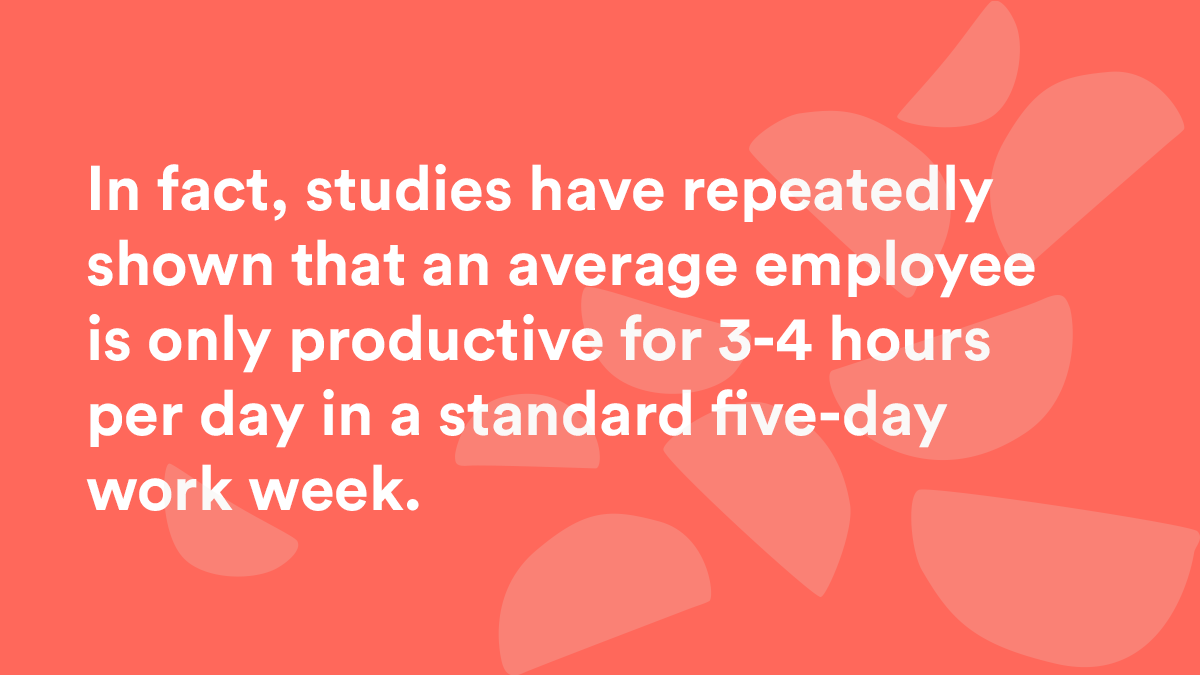
Here are 4 major ways a four-day work week can benefit everyone.
Less cost
When running a medium-sized office in the UK costs upwards of £30,000 every year, an extra day off every week can make work significantly more affordable.
Employees save on office commutes, offices save on renting and administrative expenses, and everyone enjoys slightly heavier pockets.
This is, of course, assuming no increase in daily work hours from Monday to Thursday. The trial requires that employees work their standard 7-8 hours only (and not cram five days’ worth of work into four). As long as that condition is maintained, a four-day work week is a smart way to save money.
A more equitable workplace
What does a three-day weekend mean to you? More pull-ups at the gym? More time to learn a new hobby? More well-deserved rest?
For HR Manager Charmaine St John, it means being on equal footing with her colleagues. Charmaine took a pay cut in 2018 to shift to a four-day work week and spend the three-day weekend caring for her children.
She no longer needs to lose money to manage both worlds.
“It’s mostly working moms coming back from maternity leave who move to four days and take a pay cut,” she says. “[But] with this trial, men can spend more time with their kids and in general, everyone is freed up for long weekends.”
Such testimonials add a completely new layer to the benefits of a four-day week. Having an extra day off can create a systemic difference for marginalized groups and foster a more inclusive work environment. This potentially puts the four-day work week on par with other organizational efforts at leveling the playing field — like the suggestion to implement geo-neutral salaries.
Improved health
Mental health isn’t exactly having the run of a lifetime. With studies suggesting 1 in 6 employees suffer mental health issues every week, and the pandemic making mental illness numbers skyrocket, we’ll happily take any measure that puts the workforce in a more sustainable psychological position.
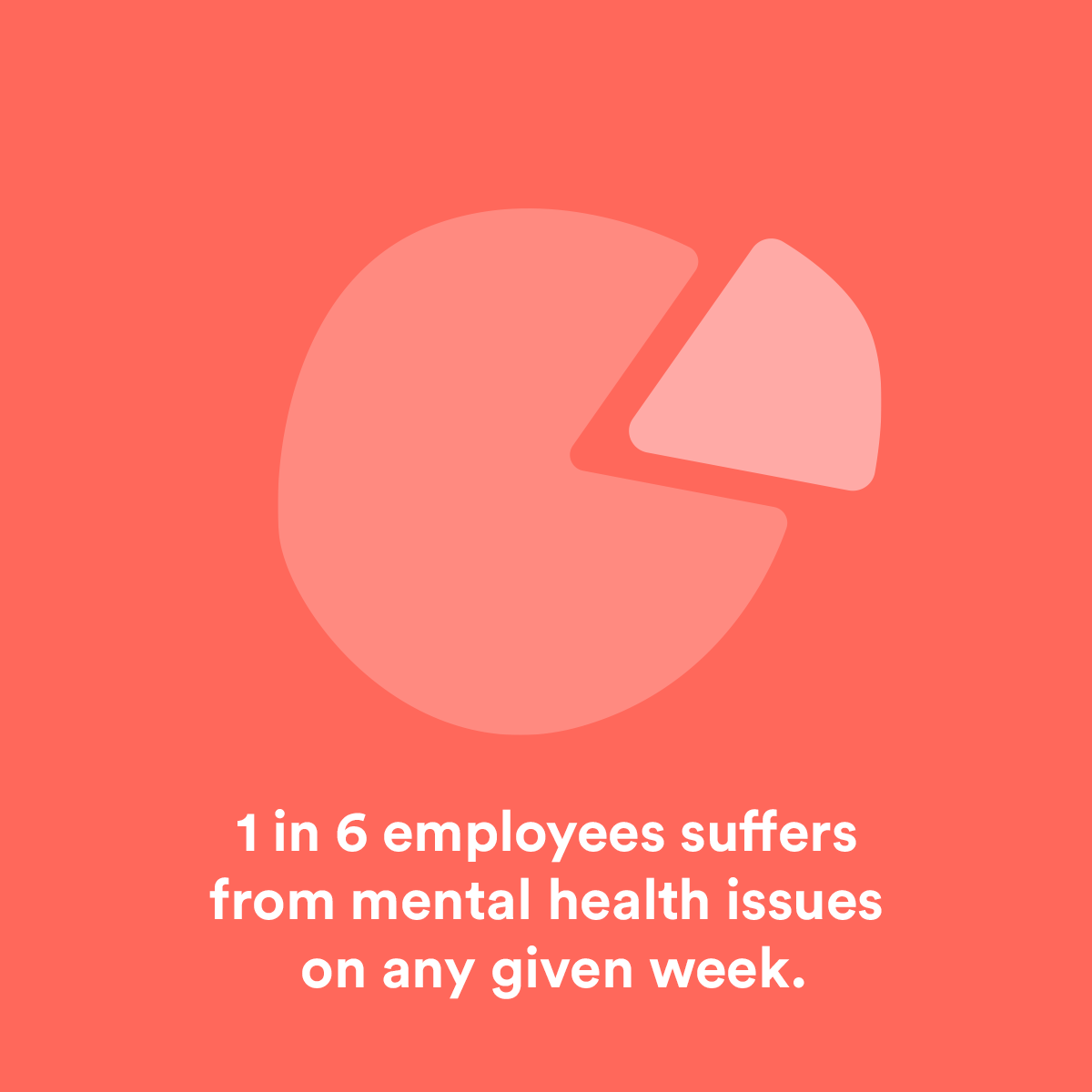
With a three-day weekend, employees can schedule one day for physical activity, one day for mental stimulation (practicing a hobby, meditating, etc.), and one day for rest. People have more time to themselves (and away from work), which reduces stress and makes work more rewarding.
Increased productivity
Let’s address the elephant in the room: a four-day work week does not necessarily mean slower company growth.
We believe that when people are happy in their individual lives, they willingly put in the work required to complete projects, meet deadlines, and carry the company forward. This is the central idea behind the project — by ensuring a healthier, more well-balanced lifestyle, we can maximize the amount of productivity we show when we’re actually at the workplace.
Why do we believe this? It’s what the numbers seem to say so far. A New Zealand firm called Perpetual Guardian trialed a four-day work week in 2020. The number of employees who successfully maintained their work-life balance jumped from 54% to 78% as a consequence of the shift in the number of workdays.
As companies, both on-site and distributed, slowly grind back into motion, everyone is looking for something that will make them eager to start work on a Monday morning. Four-day work weeks might just be that (not-so) secret ingredient.
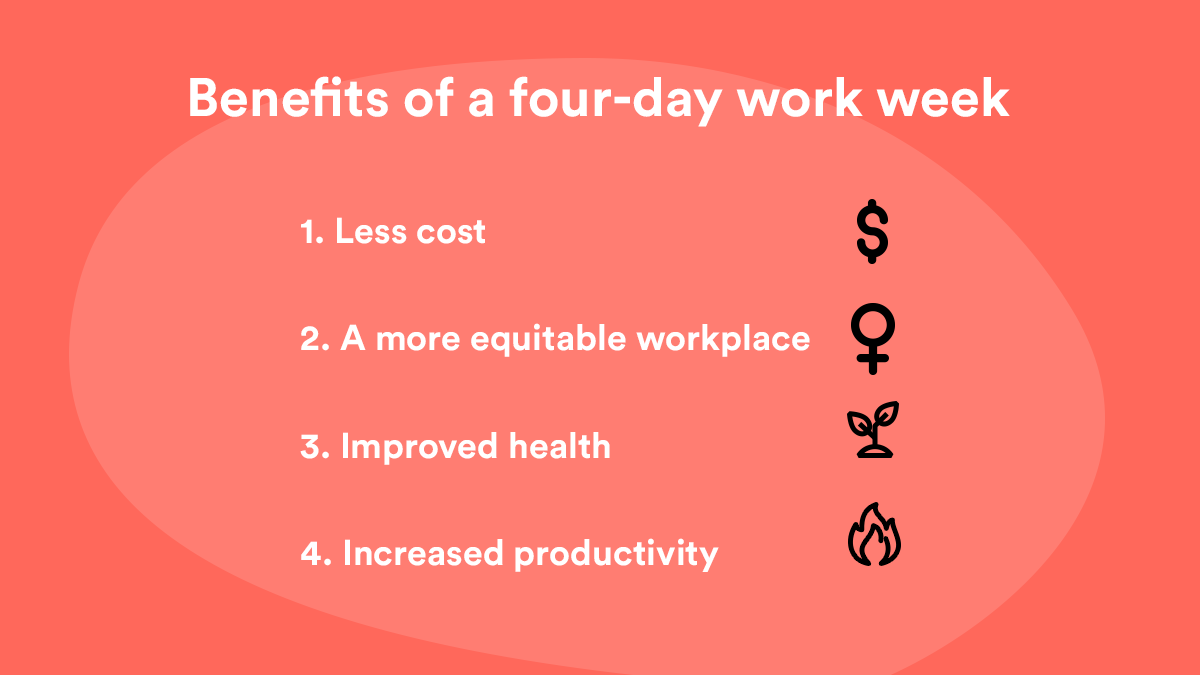
The challenges of a four-day work week
That said, every decision that seeks to change a well-established norm comes with its risks. The four-day work week is no different, and we understand that. Here are some prominent challenges that this move is likely to bring in a participating company.
Sticky Fridays

For starters, it takes some practice to get used to thinking about projects in terms of four-day weeks. Work fills the space you give it, and there’s a tendency to treat Friday as an ad-hoc workday — something we’d definitely like to avoid.
As a possible solution, consider limiting employee access to communication channels on their off-days. Accounts such as Slack, Asana, Notion, Google Docs, etc., can be made inaccessible for three days a week to ensure that employees don’t nurture the habit of checking their notifications. This eliminates the significant stress that comes with staying online on a holiday, and ensures that employees make complete use of their extended weekend.
Communicating the change to important stakeholders
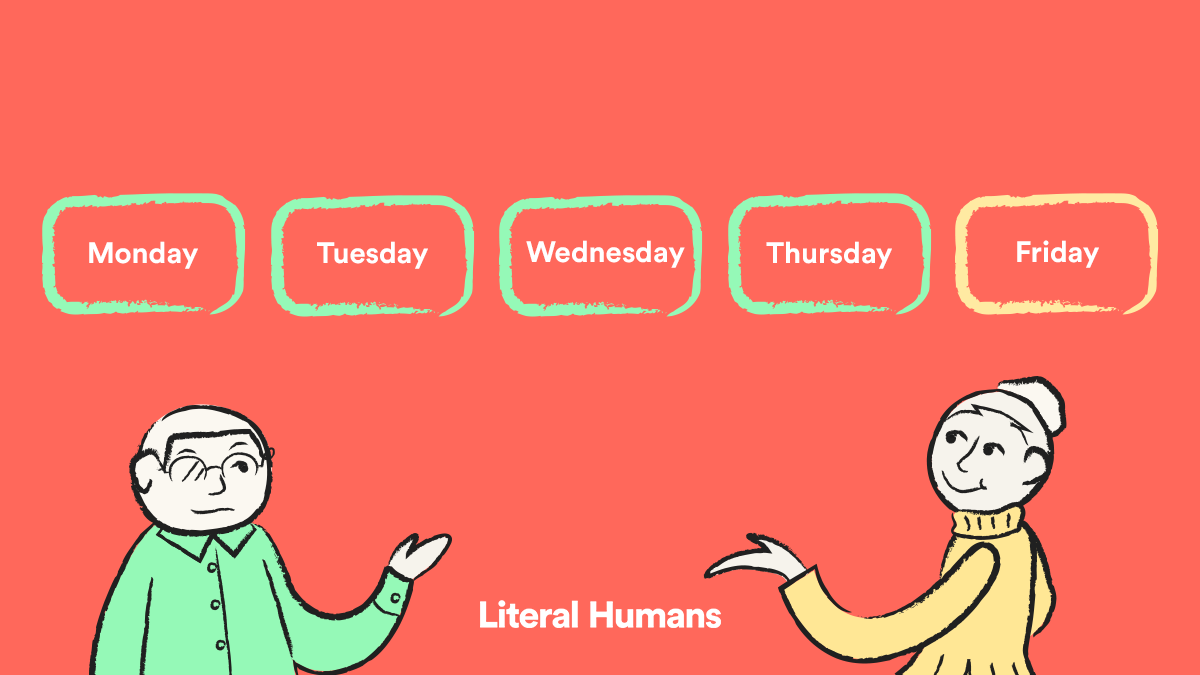
Coordinating the various moving parts of the four-day work week with external stakeholders might prove a challenge too. Your company probably works closely with other companies that do not have four-day work weeks (yet!), and adapting to this shift while maintaining solid relationships might require some organizational wizardry.
One possible solution is to split your team into two sections: one that works Monday-Thursday and the other that works Tuesday-Friday. That way, someone is always present in the office to respond to requests that can’t wait until the following week. Your employees all enjoy a three-day weekend and you sustain a positive rapport with stakeholders.
Compressed work hours

This problem has a lot to do with the old definition of a four-day work week — before the pandemic, four-day work often meant compressing the 40-hour work week into four days instead of five, making employees work 10 hours every day to afford the fifth day off.
This isn’t what the UK pilot is trying to do.
Working more daily hours to compensate for the off-day defeats the purpose of moving to a four-day work week. To derive honest, tangible results from this experiment, companies need to drop the fifth day while keeping the work hours of all other days identical.
To ensure this happens, it’s important to conduct regular check-ins and remind your team not to push themselves to breaking point to ‘deserve’ the absent Friday. If your team is struggling with logging off at the 8-hour mark, you could try phasing the shift instead of instituting it at once.
Practise 8.5-9 hour workdays to begin with; then slowly reduce the duration to 8 hours. This helps your employees ease into the change and mentally adapt to their new timetable.
Trust and communication
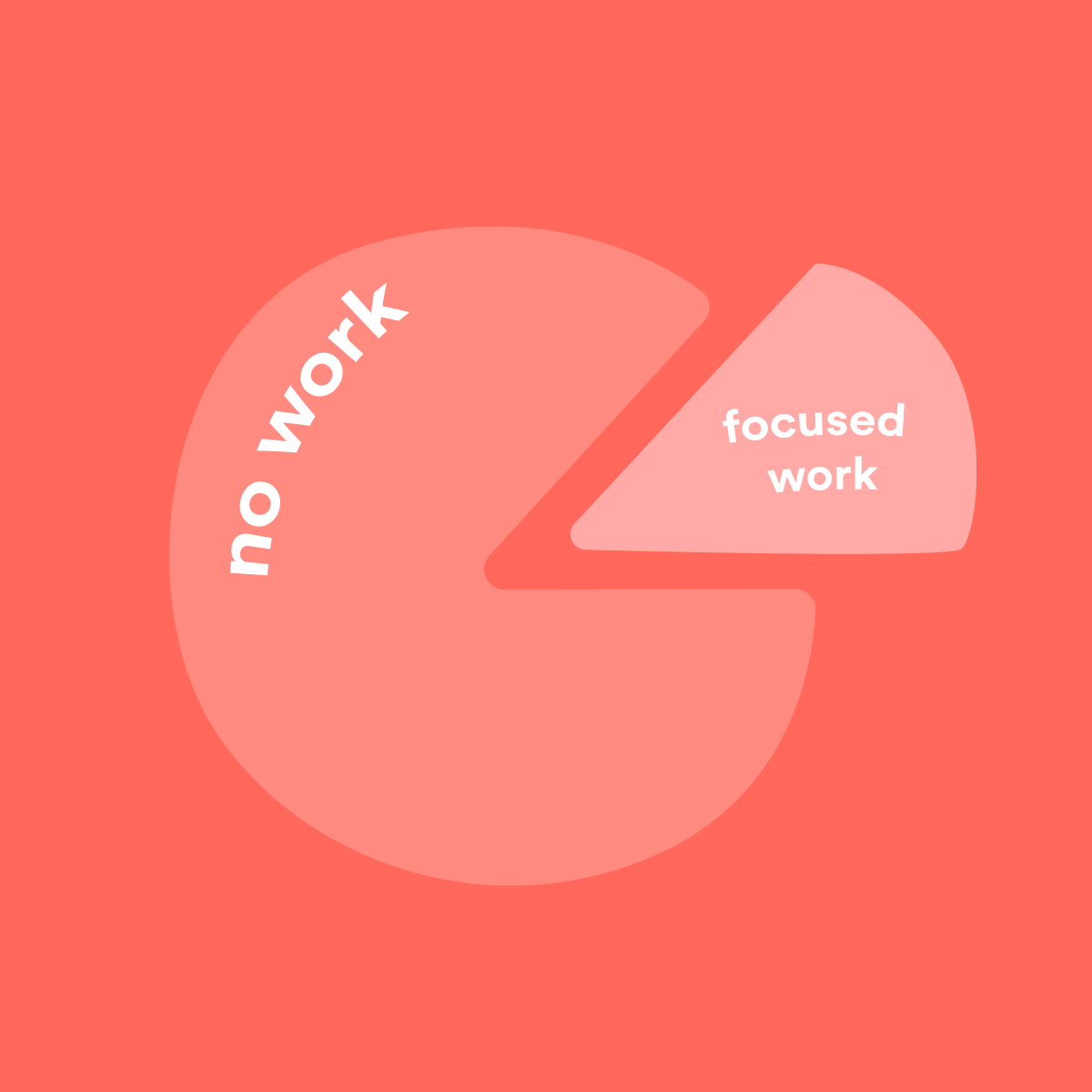
Finally, it takes real commitment and trust to hold a four-day week together.
A week has 168 hours in total, out of which four-day workers work 32 hours (Roughly 19%).
Thus, the four-day work week is essentially a two-way promise — companies promise employees that they will not be called to work outside this slice of time — in return for the promise that employees stay focused and maintain a standard of excellence while they’re working.
Maintaining this balance requires frequent and transparent communication from both sides.
Opacity in communication has already been a major factor behind not initiating the four-day work week trial sooner; statistics have shown that 66% of surveyed workers wanted three days off while only 17% employers provided that option.
To ensure we don’t recreate this gap, team members from all positions in the company need to participate in regular meetings and set time aside specifically to discuss the efficacy of the four-day work week. Issues such as compressed hours, sticky Fridays, and stakeholder relationship management need to be openly brought up and proactively addressed.
The four-day work week — a new chapter to an old dream

Niraj Chokshi hit the nail on the head when he called the four-day work week the flying car of labor. For decades, the idea has somehow survived on scattered, intermittent attention — firm after firm turning it over in their heads only to abandon it before it gathered steam. The UK trial aims to change all that forever.
Given the right structural and academic focus, a rigorous review process, and a group of participant companies willing to go all the way, we sincerely believe that we’ll emerge from this trial as a happier, healthier, and more sustainable company primed to achieve new milestones.
As long as you expect our ‘out-of-office’ notices on Fridays.

